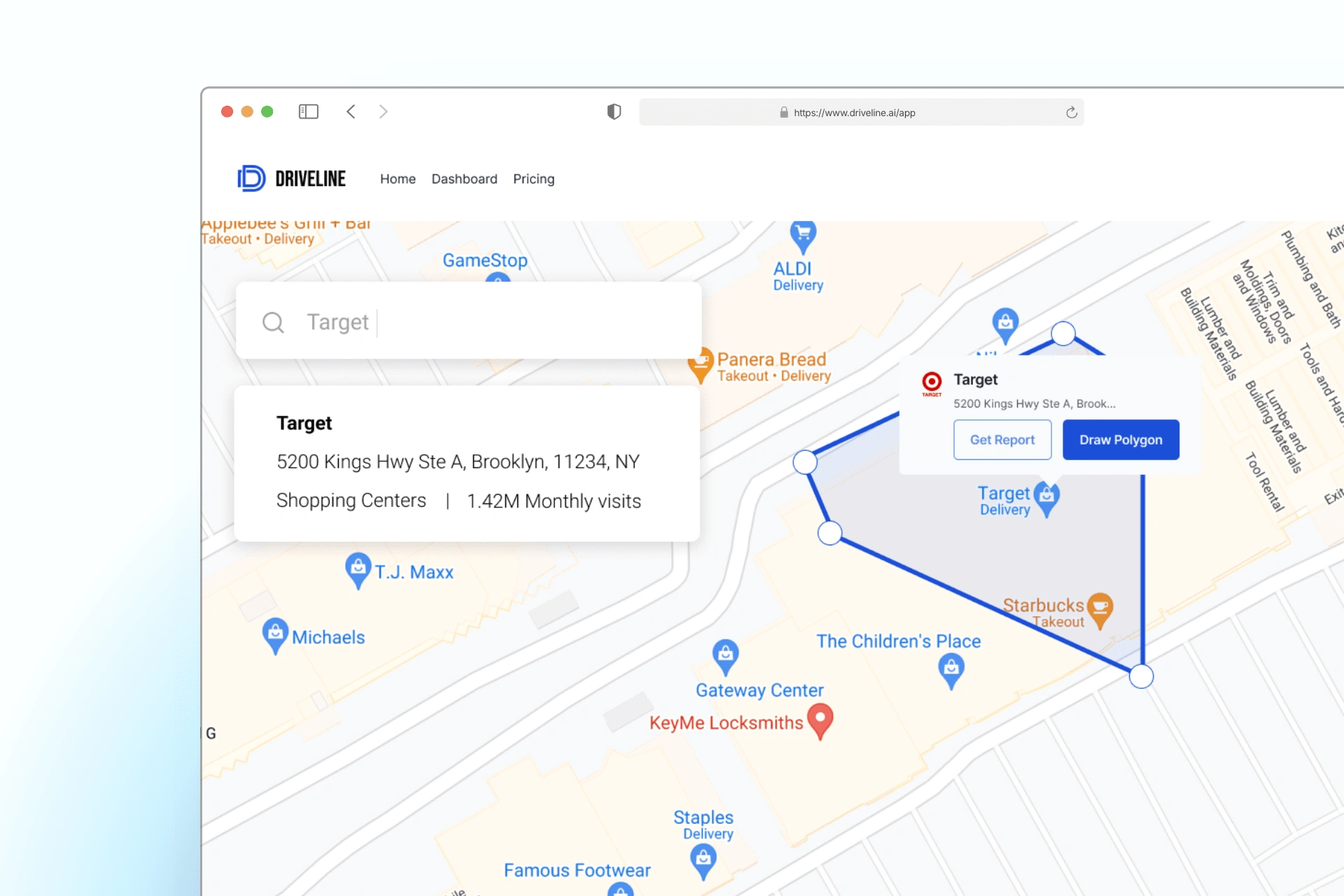DriveLine AI · Foot-Traffic & Analytics for SMB's

DriveLine AI - Audio Deepdive
DriveLine: Designing an Automotive Analytics Platform That Raised $1M — and What I Learned When It Fell Apart
When I joined DriveLine, the startup had one core goal: build an advanced analytics platform tailored for automobile dealerships. In just six weeks, I designed an MVP that helped them secure $1M in funding. What followed was an intense eight-month journey of product expansion, complex stakeholder dynamics, and ultimately, a cautionary tale about what happens when leadership shifts and focus is lost.
At the start, my role was clear: lead UX and UI for the MVP. I brought a lean, focused approach—designing a powerful but simple experience that helped dealership owners identify their store’s physical location on a map, access foot traffic and customer demographic data (powered by mobile ad identifiers), and export that data for use in advertising campaigns. It was a strong, niche-focused solution that spoke directly to a specific user: auto dealers seeking deeper visibility into their customer base.
A Clear MVP That Delivered
The MVP phase was incredibly focused. Working closely with the CTO over Slack, I designed the experience in tight feedback loops—dropping screens, receiving direct input, iterating rapidly. This created momentum and confidence in the product’s direction. Stakeholders saw real value. It was this lean, purpose-driven experience that helped secure their first $1M in funding. Before that, the company had been outsourcing design overseas with limited success. The CTO himself later said, “If it weren’t for JM, we wouldn’t have raised that funding.”
The platform offered real utility: dealers could geofence their dealership, pull demographic and foot traffic data using MAIDs (Mobile Ad Identifiers), and use that data to enrich their targeting efforts. From interface to interactions, I kept it clean, intentional, and driven by user goals.
After the Funding: Focus Drift and Rising Complexity
Once the funding came through, everything changed. Leadership began to expand the product’s vision dramatically—pivoting from a niche platform for dealerships to a broader solution targeting marketers. In theory, this sounded like a growth move. But in practice, the strategy lacked the grounding in product sense and user validation that we needed.
A new product manager joined around this time—a seasoned marketer with extensive experience in advertising but little experience in product development. He brought strong opinions and ambitious ideas, which initially energized the team. But over time, it became clear that many of the features he proposed were based more on personal workflows and marketing use cases than user feedback or product viability.
Geofencing, for example, evolved from a simple, useful interface into a highly complex, shape-shifting widget overloaded with forms, buttons, and dropdowns. While intended to reduce cognitive load, the outcome often increased it. I tried to simplify and remove unnecessary elements, but those suggestions were frequently met with resistance.
Feedback Loops That Slowed Us Down
As the platform expanded, so did the number of voices in the room. The CTO, once hyper-involved in the early design cycles, became less active. Instead, feedback came through Figma comments—sometimes over 40 on a single screen—mostly from the product manager. This created decision bottlenecks, slowed development, and added enormous pressure to “design faster” while still being expected to deliver thoughtful UX.
Ironically, the same people pushing for speed were also those introducing excessive feedback and over-scoping features. And yet, when the product failed to resonate with users, the blame subtly began to shift toward design being a bottleneck. But the deeper issue was that we had moved away from user-centered thinking. The developers didn’t have space to debug. We weren’t conducting usability tests. We weren’t talking to real users.
We had the money—but we weren’t validating or learning. We were just building.
What the Research Later Confirmed
Months later, I did deeper research into the market, and everything I suspected was true: U.S. auto dealerships lacked integrated analytics tools. They relied on patchworks of DMSs, CRMs, and Google Analytics, with poor attribution for foot traffic. Most dealers struggled to understand how advertising dollars translated into lot visits. MAIDs and geolocation-based insights offered a real opportunity to bridge that gap—but only if the experience remained focused, simple, and tailored to that niche.
The moment we tried to generalize the product to serve “marketers,” we lost sight of the niche. And the niche was everything.
Design Deliverables & Evolution
Across my engagement with DriveLine, I delivered:
A lean, focused MVP with high UX clarity
Iterative design flows developed through direct feedback with the CTO
Brand direction and stylescape work to define visual language
Responsive UI designs for dashboards, data reporting, and audience segmentation
Evolving design systems to accommodate growing features and complexity
The screenshots shown in this case study reflect the first six weeks—and still don’t cover the full eight-month scope of design work. As the product evolved, the interface became busier, more bloated, and more difficult to onboard users into—requiring tooltips, guides, and more UI layers just to explain what was going on.
A Lesson in Product Focus and Leadership
In hindsight, the DriveLine experience taught me a lot. If I had full control, I would’ve continued to focus on dealerships exclusively—doubling down on their needs, validating the product through usability testing, and rolling out new features in phases. Instead, we pivoted too fast, tried to serve too many people at once, and lost clarity on what made the MVP work in the first place.
I don’t say this to place blame—but to reflect on what it takes to build lasting products. Sometimes the pressure to prove ROI after fundraising pushes companies to chase scale before they’ve nailed product-market fit. I’ve learned that community, clarity, and iteration matter more than feature velocity. And that without strong product leadership—or the space for design to lead—things can unravel quickly.
Looking Ahead: AI, Agents & the Future of Products Like This
Reflecting on DriveLine today, I can see that products like this will likely be disrupted by AI agents and custom GPTs. Dealers won’t need a complex dashboard to extract insights. They’ll just ask an AI agent, “Who visited my lot yesterday?” or “Run an ad campaign to the devices that came to my showroom last week.” With the rise of intelligent assistants, the interface complexity that bogged DriveLine down will be unnecessary. This insight also reflects where I’m growing—developing expertise in generative AI and agent design for product innovation.
Final Thought
DriveLine was one of my biggest projects—not just financially, but professionally. I’m proud of what I built, the funding it helped raise, and how I navigated complexity under pressure. But I’m even prouder of how it sharpened my product sense.
It taught me that great products don’t try to be everything for everyone. They do one thing extremely well—then earn the right to grow.
Like this project
0
Posted Nov 30, 2024
We took DriveLine AI from concept to MVP, leveraging real-time geofencing and analytics to secure $1M in venture funding—validating both the product and market
Likes
0
Views
15
Timeline
May 7, 2021 - Apr 17, 2023







